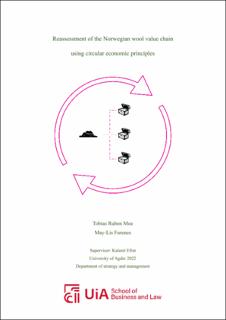| dc.description.abstract | In this thesis we have followed Norwegian wool from extraction and throughout the current
value chain. This includes a farmer, wool stations, and wool refineries. In addition, we have
sourced empirical data from key stakeholders. This consists of a representative from Norilia
and a researcher that has contributed greatly to the theme of Norwegian wool. Through an
exploratory research design, we have been able to enter a field of study without prior
knowledge. This has also allowed for incremental implementation of knowledge towards later
empirical sourcing.
The theory in the thesis concerns wool as a material, focusing mainly on Norwegian
low-category wool, but also includes global perspectives. It also provides theory on circular
economy concerning definitions, circular economy perspectives in value chains and the
applicability of circular economy.
We have applied the 4Rs of circular economy to reassess the value chain, as a means to
uncover potential alternatives to the current system. We believe that circular economy
principles can contribute to increased value creation for low-category wool. This entails
innovative measures that prevent waste, secure valuable resources inherent in the wool and
plan for future use.
The thesis contains examples on alternative uses and processing techniques. These examples
explain how conventional methods can be challenged in new ways with improved results.
Rather than an addition to the theory of circular economy, this is an attempt to use aspects of
circular economy to add to the field that concerns Norwegian low-category wool. The thesis
attempts to shine a new light on an established system and challenge its ways. The degree of
transferability to other fields is therefore present. We have built upon the work, but not
limited to, by Kirchherr on the circular economy, and the work that has been conducted in
KRUS and VerdifULL. The process has been an eye opener for us as wool has such a broad
range of applicabilities. The same can be said for the circular economy principles.
We hope that this thesis is of interest and gives you, the reader, fruitful takeaways. | |
